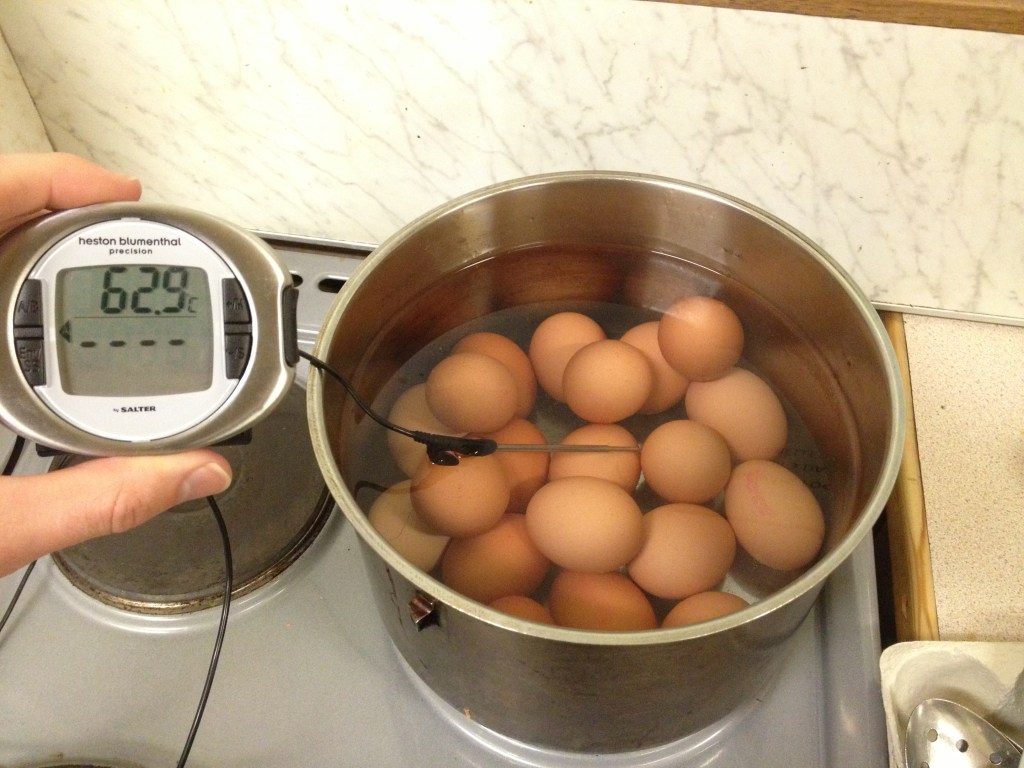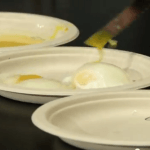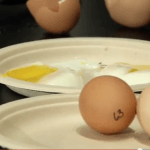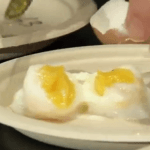To me the poached egg has always been the most delicious, but also most annoying form of the egg. I like the egg whites to be only just cooked so they are still soft, and the egg yolk to be just runny enough for me to spread it over my toast like soft butter. The only problem with poached eggs is that they are a pain to cook. There is a downside to every recipe, and good advice on cooking a poached egg is hard to find.
Unfortunately the most common way of poaching eggs that I’ve seen is the worst. You know the one I’m talking about – crack the egg into boiling water with vinegar, right where the bubbles are forming. The problem with this is that apparently you need really fresh eggs. I’ve never had eggs fresh enough for this to work. It usually turns into a big spider web in the pot. Also, I prefer my eggs without the vinegary taste. When this was the only recipe I knew of, I rarely ate poached eggs.
Then I learned on master chef, that you can tie your eggs in a little bag of cling wrap before dropping them into boiling water. This solves the wispy-strands-of-egg-whites and the vinegary taste problems, but as with the above recipe, the egg whites tend to be overcooked, and if you are doing more than 2 eggs, it takes too long. Also, cooking in cling wrap is not good practice. Who knows what it’s made of. Horse meat probably…
The next recipe I came across was by far the best. I found it in the 4 Hour Chef by Tim Ferriss1. The trick is to cook the eggs in hot water that is as still as possible (82C-93C). You are supposed to add salt and vinegar to the water, but I just add salt and it works fine. This recipe produces the best poached egg, but I’ve recently found a recipe that trumps all.
Eggs have a bunch of different proteins, all of which change state at different temperatures. All of this magic happens between 57C and 70C. The way to see the effects of each temperature is to put eggs (shell intact) in water at a specific temperature for an hour. Here’s a simplified version of what happens at each temperature2:
- 57C – egg remains unchanged
- 62C – egg white almost fully set with runny yolk (the perfect Benedict egg)
- 63C – set white, yolks set and creamy
- 64C – yolks a little thicker
- 65&66C – yolks like play dough
- 67C – yolk has granular texture
- 70C – hard white and yolk
As you can see, there is a fine line between a yolk that is set and one that is runny. If you were cooking a soft boiled egg, you would put the egg in boiling water just long enough for the yolk to reach around 62C. In reality you will probably get an egg with the yolk being around 62C in the middle and 64C+ at the outside – not entirely runny. But, if you put an egg in water at a constant temperature for a hour, the egg will become a consistent temperature the whole way through.
You might be thinking that an hour is a hell of a long time to cook one egg, and that’s true. That’s why you don’t cook just one egg. The only other downside to this method is that it requires that you be able to accurately measure the temperature of the water. A probe thermometer will do the trick and it’s an excellent tool to have as it takes the guess work out of cooking times3.
So here’s how to create the perfect poached egg, and have a delicious breakfast every morning with minimal effort:
Fill a large pot with water. Using a probe thermometer, heat the water to 64C. Add 20+ eggs (shell intact) at room temperature to the pot (be careful not to crack them). Carefully stir the eggs every so often and adjust the heat so that the water is kept at around 63C for an hour.
Remove the eggs from the water and put them back into their carton. Store them in the fridge.
For breakfast, leave the required number of eggs in hot tap water (should be around 60C) for about 10 minutes. Crack them onto toast with a sprinkle of salt, pepper, dukkah, or za’tar.
Keeping the temperature between 62 and 64C for a whole hour can be a pain depending on your stove top. What you can do instead, is stir in a little boiling water when you need to increase the temperature. If your eggs turn out to be too runny, either the temperature wasn’t constant enough, there was a crack in the egg shell, or you didn’t stir often enough.

This is a picture of the setup I use to cook a week’s worth of eggs.
</div>
I think 63 degrees Celsius produces an egg yolk of the perfect consistency for almost all uses. It’s great on toast, it’s great in egg salad, it’s great in fried rice, and it’s great in your mouth. But, you don’t have to use 63C. Choose the temperature based on the desired consistency of the egg yolk. The pictures below give some examples.





The above images are screenshots taken from the first lecture from the Science and Cooking course given by Harvard University, which you can watch for free on YouTube (see below). If you want to see the part about eggs, skip to 1:16:30 and watch until around 1:22:00.
P.S. If you combine two poached eggs on toast with a protein shake for breakfast, you should be getting over 30g of protein. All the slow carb diet / Tim Ferriss fans out there will know that 30g of protein within 30 minutes of waking up is the minimum effective dose for fat loss.
Notes.
1. This blog post shows you how to do a poached egg Ferriss style.
2. This blog post has some good information on the denaturing temperatures of protein in eggs.
3. A probe thermometer is awesome for cooking any piece of meat or fish thicker than 1″. You just poke the probe into the middle, set the temperature corresponding to how well done you like your meat, then stop cooking when the alarm goes off. It’s very difficult to overcook your food this way. Plus, they’re cheap.